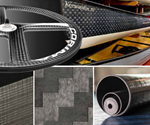Textile machinery, NCFs provide sustainable processing options
CAMX 2024: Karl Mayer is returning to CAMX with a focus on fabric- and fiber-handling equipment, in addition to its application development services.
Source | Karl Mayer North America
After a brief hiatus, noncrimp fabric (NCF) production specialist Karl Mayer North America (Greensboro, N.C., U.S.) is returning to CAMX. The Karl Mayer Group (Obertshausen, Germany) subsidiary is presenting itself as an innovative composites partner with the display of high-performance machines such as the Cop Max 4, a flexible all-rounder made to produce multilayer, multiaxial fabric structures; the Cop Max 5, specifically for processing carbon fibers; and the UD 700 fiber spreading system. Furthermore, the company is highlighting a new machine that was launched this past spring, called Max Glass Eco, for highly productive manufacturing of standard applications made exclusively from glass fiber.
Overall, the focus of the company’s medial presentation — the various medias on display at the booth — focus on the processing of natural fibers into sustainable composite reinforcements, from videos to final products made from natural fibers, as well as a sample collection. For instance, in cooperation with winter sports industry representatives, Karl Mayer has processed hemp tapes and flax fibers into NCFs for snowboards and skis using the Cop Max 4, which were launched at JEC World 2024 and Techtextil visitors.
“The global composites industry is under enormous pressure to reduce its ecological footprint,” says Lutz Heinig, sales manager technical textiles, Karl Mayer North America. “Our NCFs made from natural fibers can make an important contribution to this.”
Related Content
-
Hybrid process marries continuous, discontinuous composites design
9T Labs and Purdue applied Additive Fusion Technology to engineer a performance- and cost-competitive aircraft bin pin bracket made from compression-molded continuous and discontinuous CFRTP.
-
Sulapac introduces Sulapac Flow 1.7 to replace PLA, ABS and PP in FDM, FGF
Available as filament and granules for extrusion, new wood composite matches properties yet is compostable, eliminates microplastics and reduces carbon footprint.
-
Welding is not bonding
Discussion of the issues in our understanding of thermoplastic composite welded structures and certification of the latest materials and welding technologies for future airframes.



